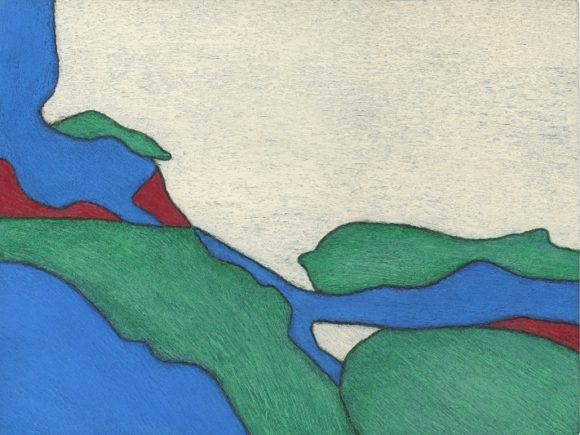
28 Jan Jerusalem Between Heaven and Earth
On view January 28–May 27, 2018
Read the exhibition catalogue here
Derfner Judaica Museum + The Art Collection at Hebrew Home at Riverdale is pleased to announce Jerusalem Between Heaven and Earth, jointly organized with the Jewish Art Salon and guest curator Ori Z. Soltes for the 2017 Jerusalem Biennale, which will be on view at the Derfner Judaica Museum from January 28–May 27, 2018.
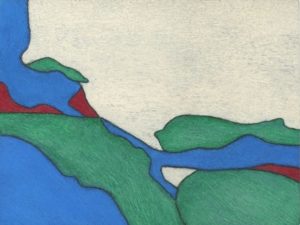
Tobi Kahn, RHYVA, from the AKHV series, 2016, acrylic on wood, 9 x 12 x 2 in. Courtesy of the artist.
The Jewish Art Salon’s exhibition was one of 26 exhibitions and projects from around the world that occupied multiple venues in Jerusalem this past fall. The Derfner Judaica Museum is honored to bring this exhibition to New York for its only US showing. Jerusalem Between Heaven and Earth includes 34 works by 30 artists who explore this year’s Biennale theme of “watershed.” According to Ram Ozeri, its Director and Founder, “The Jerusalem Biennale provides a stage for professional artists—from secular to ultra-Orthodox—who refer in their artwork to Jewish thought, spirit, tradition or experience.” The recent Biennale threw “a spotlight onto the concept of watershed, examining it from a literal, metaphorical and even historical perspective,” he elaborated. “The theme finds its expression in issues as varied as Jewish identity, immigration and refugees, alongside watershed moments in history. . . . Both in Hebrew (kav parashat hamayim) and in English, watershed is used to describe an important turning point—an event that changed the course of history.”
Ori Z. Soltes has taken the watershed theme and interpreted it with his selection of works by artists from the US, Israel, the UK and the Netherlands. According to Soltes, “A watershed yields a branching, be it of physical terrain, historical events or spiritual and aesthetic concepts. Such an idea is particularly powerful in conjunction with the city of Jerusalem” where “the spiritual foundations. . . branch in three Abrahamic directions. . . .”
Watershed ideas extend from Jerusalem’s topography to moments that shape history and thought—to contemporary aesthetics and politics. In the exhibition, paintings by Tobi Kahn and a video by Leah Caroline and Jeremy S-Horseman offer abstract suggestions of the geological watershed that helps define Jerusalem. In her video, Sarah Lightman turns that topography inward toward life’s profound watershed moments.
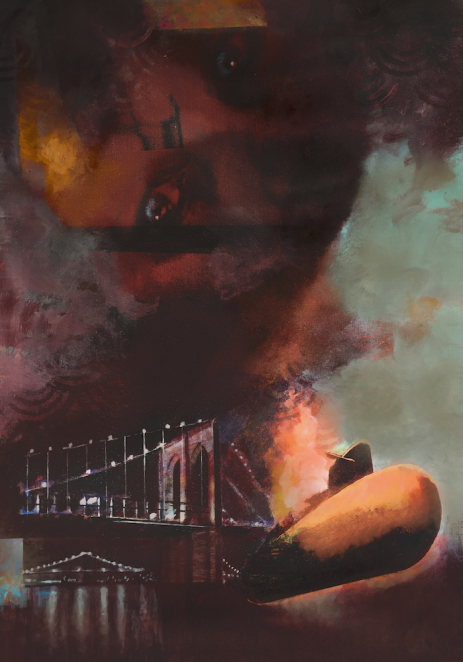
Yona Verwer and Katarzyna Kozera, The Book of Yona 5, 2017, acrylic paint, digital painting collage on canvas with augmented reality, 36 x 24 in. Courtesy of the artists.
Joel Silverstein’s painting Promised Land—here the beach at Coney Island—is a reference to biblical Israel and to the American Jewish immigrant experience. Richard McBee’s painting Exodus Redux suggests watershed moments of the biblical Exodus that pushed the Israelites toward Sinai and from there toward Jerusalem and the building of Solomon’s Temple. Solomon is traditionally discussed as the author of the Book of Ecclesiastes, explored in Ellen Holzblatt’s paintings. Gabriela Boros considers the watershed warnings to the Israelite-Judeans by the Prophet Isaiah. The universal message of the Book of Jonah is the focus of Yona Verwer and Katarzyna Kozera, of Jan Lauren Greenfeld and of Alan Hobscheid. The tradition of rabbinic commentary is encountered through works by Rachel Kanter, Beth Krensky and Ben Schachter. From there the mystical strains of Judaism emerge in Susan Schwalb’s small, tight abstractions. In Carol Buchman’s work the mystical and geological become panentheistic: the Name of God suffuses nature.
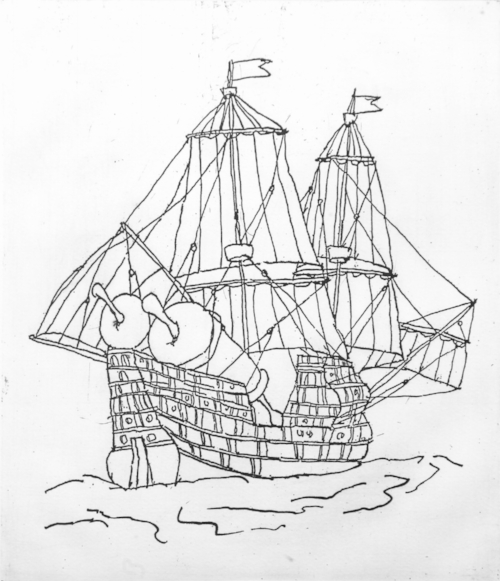
Away from the sacred city, Jewish history and thought seek a return to Jerusalem—particularly at harsh watershed diaspora moments. Mark Podwal’s 1492 references the Expulsion from Spain; Billha Zussman imagines how that external watershed has internal consequences; Archie Rand offers cutting edge—watershed—visual references to the Shoah or Holocaust.
Jerusalem also reaches into Islam and Christianity. Siona Benjamin’s work reflects her background as a Jewish woman from predominantly Hindu and Muslim India, now living in the US. In Exodus #5, one from a series of paintings that considers the current wide-spread refugee crisis, she interweaves that issue with an exploration of how PaRDeS (as a Jewish, and particularly a Jewish mystical concept) intersects the equivalent Islamic concept of Jannat. In her abstract monoprint, Miriam Stern reimagines the Christian vision of the Hebrew Bible depicted in the Morgan Library’s 14th-century French illuminated manuscript known as the Crusader Bible.
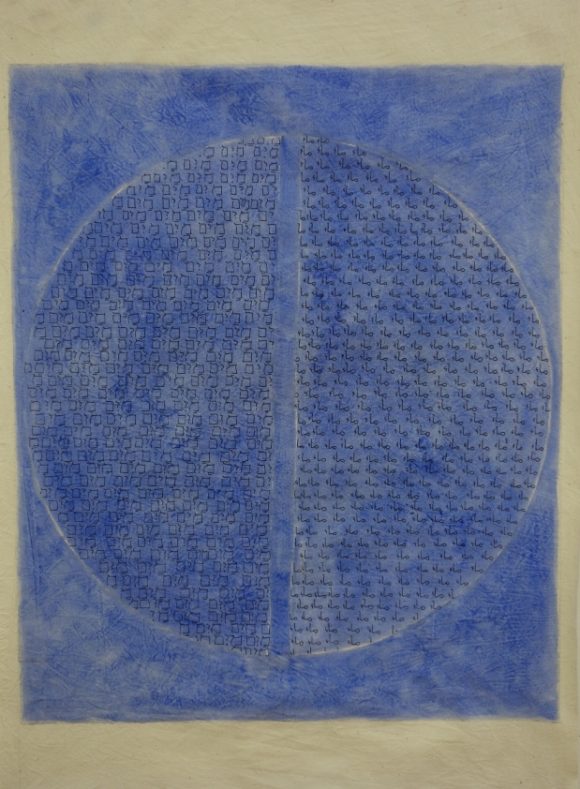
Jane Logemann, Water-Hebrew/Water-Arabic, 2017, ink and oil on muslin, 30 ¼ x 19 1/8 in. Courtesy of the artist.
Contemporary Jerusalem offers Aviva Shemer’s installation of suspended Hebrew, Arabic and Latin (English) letters, inspired by Martin Buber’s discussion of Jerusalem as a center of Am ve’Olam (A People and the World); Jane Logemann’s frenetic Hebrew and Arabic repetitions of the word “water” transform into abstract images. In her painting, Leah Raab imagines the Valley of Tears, the site of a massive assault in the Golan Heights during the Yom Kippur War. In two photographs, Dorit Jordan Dotan focuses on the crisis of Israeli-Palestinian water-sharing and the geological processes at work separating water from salt at the Atlit salt flats. Bruria Finkel turns the issue of potable and salt water back toward the geology of Jerusalem. Yehudis Barmatz-Harris turns water to fire as history moves back from the crucible of Jerusalem’s return to Jewish hands to the purification process of the Israelites in the wilderness and the burning of the Red Heifer. Pamela Fingerhut returns viewers to the moment when Moses is placed in the Nile, in this case by a modern day Miriam. Elaine Langermann’s mixed media work, Poem/Painting #11—“Watershed,” combines image and text to ask what art is and where we move forward, intersecting the questions: what is Jewish art? And what is Judaism? Both of these are suffused by questions—like the city of Jerusalem itself.
ABOUT THE CURATOR
Ori Z. Soltes teaches theology, philosophy and art history at Georgetown University, Washington, DC. For seven years, Dr. Soltes was Director and Chief Curator of the B’nai B’rith Klutznick National Jewish Museum, where he created over 80 exhibitions focusing on aspects of history, ethnography and contemporary art. He has also curated diverse contemporary and historical art exhibitions at other sites, nationally and internationally. As Director of the National Jewish Museum he co-founded the Holocaust Art Restitution Project and has spent nearly 20 years researching and consulting on the issue of Nazi-plundered art.
Dr. Soltes has lectured at dozens of museums across the country, including The Metropolitan Museum of Art, the National Gallery of Art, the Smithsonian Institution, the Art Institute of Chicago and the Los Angeles County Museum of Art. He has been interviewed for a score of programs on archaeological, religious, art, literary and historical topics on CNN, the History Channel and Discovery Channel. Nearly 250 publications—books, articles and catalogue essays—have included, among others: Tradition and Transformation: Three Millennia of Jewish Art and Architecture and Fixing the World: Jewish American Painters in the Twentieth Century. OriZSoltes.com
ABOUT JEWISH ART SALON
The Jewish Art Salon is the largest, most-recognized Jewish visual art organization in the world. It is a global network of contemporary Jewish art. The Salon provides important programs and resources, and develops lasting partnerships with the international art community and the general public.
The Jewish Art Salon presents public events in the US and Israel, and produces art projects with international art institutions. Since 2008 the Jewish Art Salon has organized dozens of art exhibits and events exploring Jewish themes, related to current issues. In the New York area it hosts occasional salon sessions with international artists and scholars. JewishArtSalon.com

